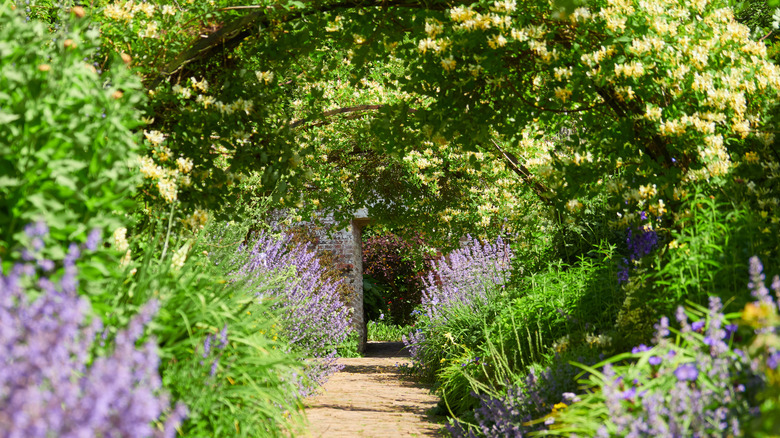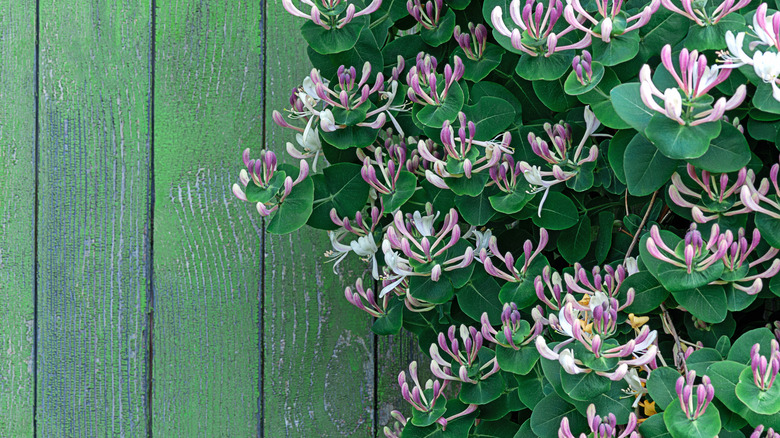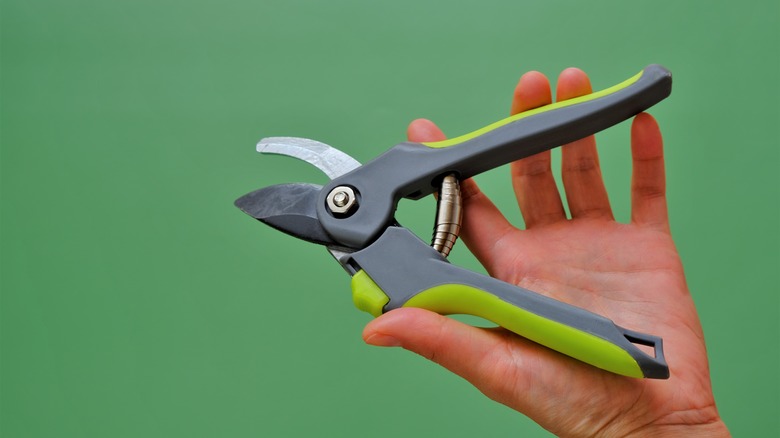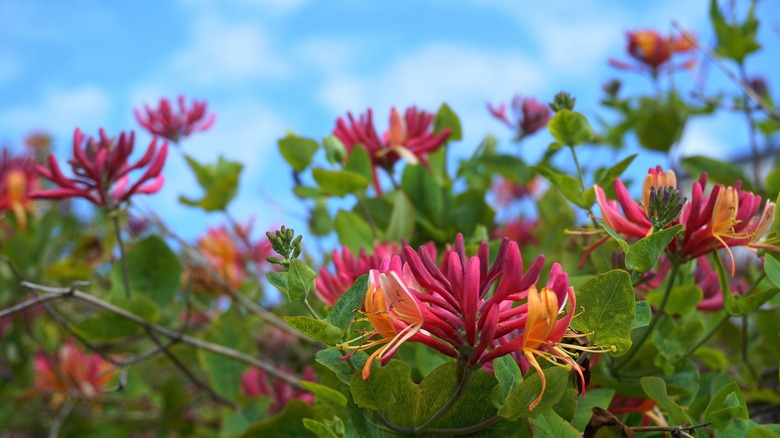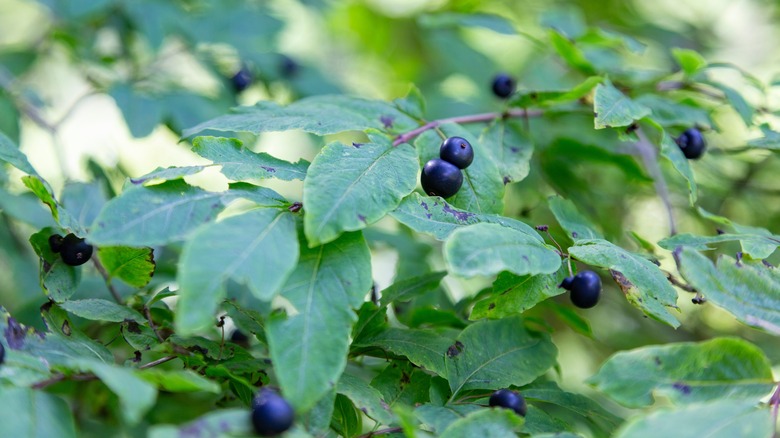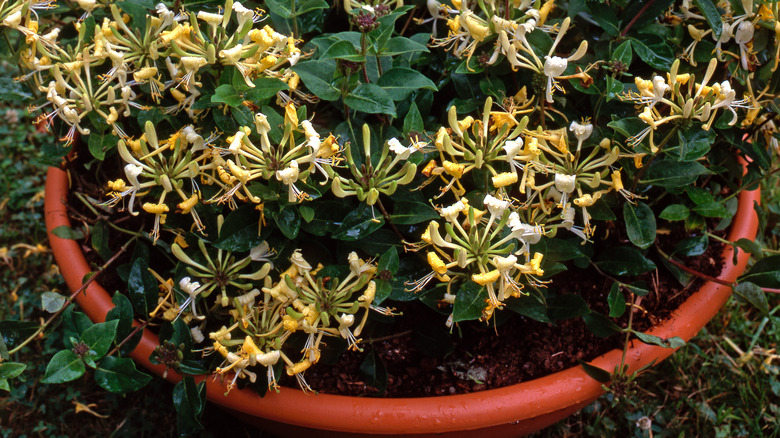Honeysuckle: Everything You Should Know Before Planting
Commonly known as honeysuckle, Lonicera is a genus of ornamental plants loved by gardeners everywhere for their sweet scent and beautiful flowers (via Britannica). Honeysuckle leaves typically grow symmetrically and are dark green or blue-green in color. The flowers can be pink, red, yellow, white, or orange and are tubular in shape. Honeysuckle plants also produce red, orange, or black berries that attract birds to your garden. The sweet-smelling plants grow either as shrubs or vines and are loved by wildlife such as bees, hummingbirds, and butterflies, according to Gilmour.
Honeysuckle is generally a hardy plant that grows readily and can even become invasive if left to its own devices. It makes a beautiful, easy-to-care-for perennial in a backyard or garden. For generations, children have sucked the honey-like nectar from honeysuckle flowers as a sweet treat. Many cultures have also used honeysuckle to treat ailments ranging from snakebites to pneumonia (via Garden Guides).
How to use in the garden
Climbing varieties of honeysuckle make an attractive covering on a wall or fence with a little assistance from a trellis to get them started. They can be used creatively to dress up an archway or pergola to create a romantic effect. Honeysuckle vines are generally easy to grow and can also be used as ground cover or grown in containers, according to Gilmour. Vining honeysuckle can be planted in a pot with a trellis or a hanging pot and allowed to trail down in lovely, sweet-smelling tendrils, Gardening Know How recommends.
Shrub varieties of honeysuckle work great as hedging, bordering an area of your garden, or simply as a garden accent. As hedges, honeysuckle can provide privacy to your yard in addition to beauty and a pleasant smell. When used as hedges, they can be allowed to grow in their natural, more wild shape or well-pruned to form uniform lines.
How to grow honeysuckle
If you'd like to incorporate honeysuckle into your outdoor space, you'll need a spot that gets at least partial sun, moist but well-draining soil, and a trellis or other growing support if you choose a vining honeysuckle species. Gardener's World recommends choosing a location for vining varieties where their roots can be in the shade and the stems in the sun, if possible. This replicates the way that they grow in the wild, climbing upwards towards sunlight with their roots shaded by trees. Honeysuckle shrubs also do well in full or partial sun.
Work some compost into the soil before planting your honeysuckle for a successful start, Gardener's World recommends. For climbing varieties, plant them 6 to 12 inches away from the fence, wall, trellis, or other structure you want the plant to climb (via Gilmour). To create a hedge, Gardener's World suggests spacing young plants about 8 inches apart. No matter which variety, give your honeysuckle a thorough watering after planting.
How to care for honeysuckle
Once your honeysuckle is established, it is easy to take care of. Water regularly the first year, then only as needed to prevent the soil from drying out (via Love to Know). The soil should be moist, not overly wet or dry. Mulching yearly with compost will help retain moisture. For the best results, feed your honeysuckle every spring with a low-nitrogen fertilizer or compost, Gilmour recommends.
When it comes to pruning your honeysuckle, it's essential to understand which variety you have. For honeysuckle vines that flower in the early summer, prune off one-third of the plant after the flowering season, Gardener's World explains, whereas late summer bloomers should be pruned sparingly in the spring. Prune deciduous shrub varieties in spring or summer after they flower, and prune evergreen shrubs in the summer. If you need to do a major pruning or reshaping session of your honeysuckle, you should do so in the winter. To produce berries, leave dead honeysuckle flowers on the plant.
Honeysuckle varieties
There are over 180 species of honeysuckle, most of which are native to China, according to Britannica. Honeysuckle comes in deciduous and evergreen varieties of both vines and shrubs. Vining species can climb 25 feet, and the shrubs can grow up to 15 feet tall, according to Love to Know. At least 20 species grow in the United States and typically do well in hardiness zones five through nine, per Gilmour.
- Trumpet honeysuckle, or Lonicera sempervirens, is one of the most common species, sometimes referred to as coral or scarlet honeysuckle. Featuring pink or red flowers, trumpet honeysuckle is a semi-evergreen climbing variety that grows 3 to 20 feet long (via Lady Bird Johnson Wildflower Center). This variety does particularly well in the southern United States.
- Japanese honeysuckle, known under the scientific name Lonicera japonica, is one of the most common varieties but is considered invasive. It is a vining type of honeysuckle with red or pink flowers and flourishes in the Midwest.
- Winter honeysuckle, or Lonicera fragrantissima, is a common shrub variety with white blooms and is also considered invasive in some areas. According to Gilmour, it can be potted successfully.
- Common vine honeysuckle, classified as Lonicera periclymenum, is a climbing variety featuring white or pink flowers and flourishes in most areas of the United States.
- Dropmore Scarlet (Lonicera x brownii) is a vining honeysuckle with red flowers that bloom throughout the summer, according to Love to Know.
Is honeysuckle toxic?
While the nectar from honeysuckle flowers is safe to consume, the berries of some varieties should not be eaten by humans or pets and are considered toxic if consumed in large amounts. According to SF Gate, eating a large number of poisonous berries could cause nausea, vomiting, diarrhea, increased heart rate, and even death in extreme cases. The stems and vines of some varieties are also considered mildly toxic. Common species that contain materials toxic to people and pets include Japanese honeysuckle and trumpet honeysuckle, according to Garden Guides. Winter honeysuckle is not toxic, but it is best to avoid ingesting honeysuckle berries to be safe.
Although honeysuckle plants and berries are generally only considered mildly toxic in large quantities, they should not be consumed by people or pets due to the potential risks. Call your local poison control or seek medical attention if a poisonous variety is consumed in large amounts.
How to repot honeysuckle
Although honeysuckle generally does best in the ground, some species can be potted. Make sure to choose a very large pot with proper drainage. Gardening Point recommends a pot 30 inches deep and a top diameter of 20 inches.
When potting or repotting honeysuckle, Gardening Point advises filling your pot most of the way with compost before adding the honeysuckle root ball and filling the rest of the pot with soil. Tamp down around the plant gently to remove any air pockets. If your honeysuckle is a climbing variety, give it a trellis or place it next to another surface that it can climb. If needed, you can guide the vines by loosely tying them to the trellis.
Make sure that you place the pot where your honeysuckle can get some sun, and be mindful that the soil doesn't dry out. Regular watering and a layer of compost mulch can help the soil stay moist.

